The NVIDIA GeForce GTX 650 Ti Review, Feat. Gigabyte, Zotac, & EVGA
by Ryan Smith on October 9, 2012 9:00 AM ESTOverclocking: Power, Temperature, & Noise
Our final task is our look at the overclocking capabilities of our GTX 650 Ti cards.
Because the GTX 650 Ti is based on a lower clocked GK106 we should have more headroom to play with. Furthermore because GPU Boost is not present, and hence NVIDIA is not min-maxing GPU clockspeeds in the first place, there should be even more headroom to play with. For overclockers dissatisfied with overclocking in the world of GPU Boost, the GTX 650 Ti is going to be a return to old fashioned overclocking.
As an added benefit, because GPU Boost is not present NVIDIA is not operating these cards so close to their 1.175v limit. While it’s true the 1.175v limit is still in place, with the average shipping voltage being nearly 0.1v below that limit there’s some overvolting headroom to play with that GeForce 600 cards don’t typically get to experience.
| GeForce GTX 650 Ti Overclocking | ||||||
| Ref GTX 650 Ti | EVGA GTX 650 Ti SSC | Zotac GTX 650 Ti AMP | Gigabyte GTX 650 Ti OC | |||
| Shipping Core Clock | 925MHz | 1071Mhz | 1033MHz | 1033MHz | ||
| Shipping Memory Clock | 5.4GHz | 5.4GHz | 6.2GHz | 5.4GHz | ||
| Shipping Load Voltage | 1.087v | 1.05v | 1.087v | 1.087v | ||
| Overclock Core Clock | 1175MHz | 1175MHz | 1175MHz | 1175MHz | ||
| Overclock Memory Clock | 6.6GHz | 6.6GHz | 6.6GHz | 6.6GHz | ||
| Overclock Load Voltage | 1.162v | 1.15v | 1.162v | 1.162v | ||
When we’re looking at cards similar to a reference design it’s not unusual for those cards to top out at similar clockspeeds. It’s not even rare to have two cards top out at the same spot. But it’s highly unusual to have all 4 cards top out at the same point: 1175MHz core and 6.6GHz memory. Despite our best efforts each and every card would fail 1200/6.7 at some point, forcing us back down to the clockspeeds you see above. Perhaps what is most interesting is that none of the factory overclocked cards managed to push higher than our reference card, or even higher than one-another for that matter. Given what we’re seeing it looks like GK106 is naturally capable of 1050MHz+ clockspeeds, so the amount of failed chips coming out of factory overclock binning should be minimal.
Oddities aside, these overclocks are quite good. Compared to the reference GTX 650 these clocks represent a 250MHz (27%) core overclock coupled with a 1.2GHz (22%) memory overclock. These are far greater overclocks than what we’ve seen on any other GeForce 600 series card to date, once again thanks to the fact that the GTX 650 Ti’s clockspeeds are so low due in large part to a lack of GPU Boost. Budget overclockers will almost certainly be quite pleased with the GTX 650 Ti, though it’s worth noting that its closest competition is the similarly overclocking-friendly 7850.
Moving on to our performance charts, we’re going to once again start with power, temperature, and noise, before moving on to gaming performance.
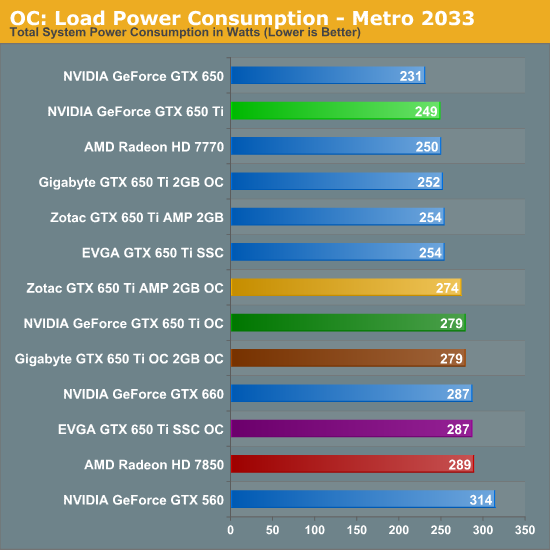
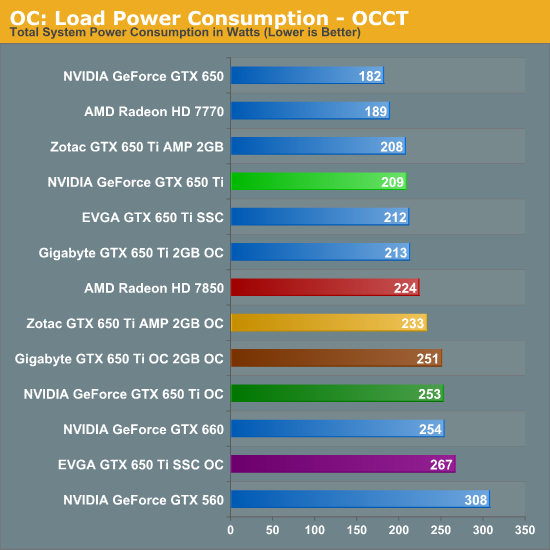
Unlike overclocking cards with GPU Boost, in the case of the GTX 650 Ti we are unquestionably overvolting the card. As a result the power consumption penalty for overclocking is quite harsh on a relative basis, though thankfully the GTX 650 Ti starts out low enough that the PCBs and the coolers are having no problem keeping up.
Overall, our overclocking efforts have pushed the power consumption of our GTX 650 Ti cards up by 30-40W, which puts power consumption just below the GTX 660 and 7850. The best performing card in this regard – that is, the card with the smallest increase in power consumption – is the Zotac card, followed by the close pairing of the Gigabyte card and the reference card, and finally EVGA’s card. This is one of those cases where a sample size of 1 just isn’t big enough, so there’s no clear reason why Zotac does so well or EVGA fares so poorly. Looking at temperatures it may be that we’re seeing temperature induced leakage, then again it may be that the hottest card is the hottest because of that power consumption.
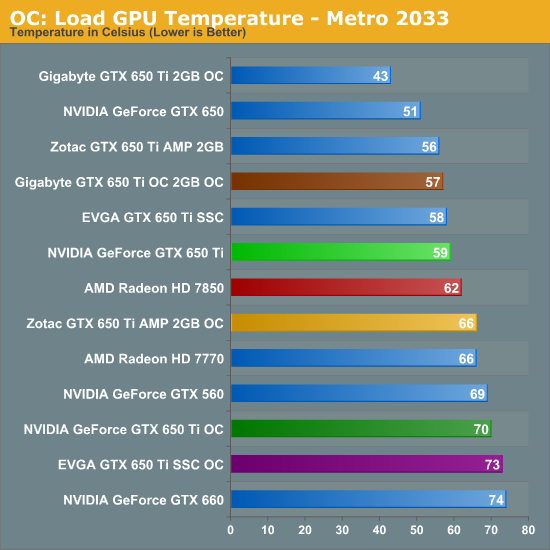
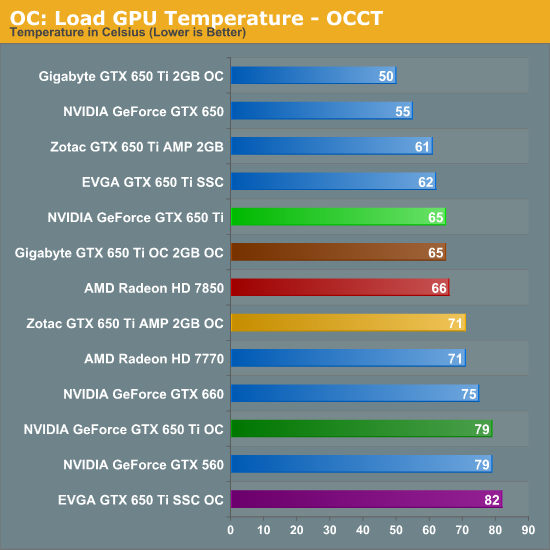
Next up is load temperatures. As we’ve already seen in our look at stock performance the Gigabyte card has a relatively aggressive fan curve, which is great for temperatures at the cost of noise. As a result even in the worst case scenario of OCCT it only hits 65C, 6C cooler than the next-closest overclocked card. That brings us to the Zotac card, which isn’t as cool as Gigabyte’s card but at 71C is still doing rather well. This is followed by the reference card at 79C, and finally the EVGA card at 82C.
Given the amount of power we’re channeling through these cards, it’s rather surprising just how well they hold up here. Even with these small coolers GPU temperatures are well into the safe zone, though the EVGA card is about as hot as we’d let such a card get under normal circumstances.
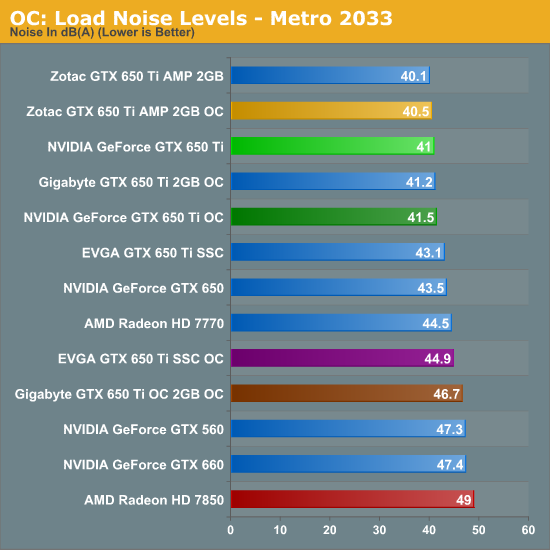
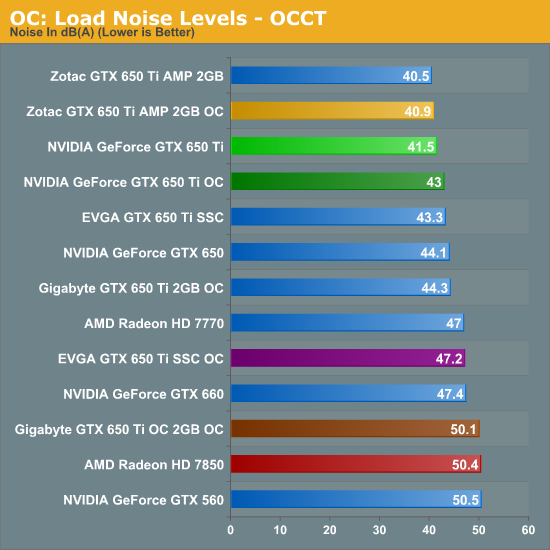
Moving on to noise, the cards that were previously doing well with stock settings continue to do well, while the rest of the cards fall further behind the leaders. The quietest card remains the Zotac, which even overvolted and running OCCT still doesn’t pass 41dB(A), which is simply incredible given the amount of power it’s pulling by this point. And as we’ve already seen its temperatures are respectable too, so Zotac seems to have hit the perfect balance here.
At the other end of the spectrum we have the EVGA and Gigabyte cards. Gigabyte continues to fall behind due to their aggressive fan curve, while the EVGA card and its poor overclocked temperatures require the card to push the fan even harder to keep up. Neither one of these cards is doing an acceptable job in light of what the Zotac card nor the reference card are achieving.










91 Comments
View All Comments
chizow - Tuesday, October 9, 2012 - link
I guess in years past this may and probably should've been branded GTS 650Ti along with the GTS 650 (they've used GTS 250, GTS 450 etc in the past), but I know for a fact Nvidia is trying to establish GTX as its own brand for gamers.They really emphasize it with all this "Green Light" business with regard to overclocking, overvolting etc.
Blazorthon - Tuesday, October 9, 2012 - link
Nvidia has been cracking down on overvolting support, so IDK if I'd give them that much credit.Pneumothorax - Tuesday, October 9, 2012 - link
That will make the price/performance gap even worse as the 7850 is an oc beast.goinginstyle - Tuesday, October 9, 2012 - link
So why no reviews of the Asus or MSI offerings in these roundups?silverblue - Tuesday, October 9, 2012 - link
You need to be sent a card in order to review it. ;)Shadowmaster625 - Tuesday, October 9, 2012 - link
The 7850 1GB is $150. It IS is the direct competitor to the 650 ti. You can speculate all you want about the 1GB being some sort of ephemeral limiting factor, but I dont see it. All I see is that in one game, at BEYOND 1080p resolution, memory becomes a factor. But if you look at it, you can see that it is still so very close on the bell curve. I bet that if you actually tested Skyrim at 1920x1080 (not 1920x1200), there would be much less difference between 2GB and 1GB.Even 2 years from now the 7850 1GB is going to be a better performer than the 650ti. Even with the "latest and greatest" games.
Shark321 - Tuesday, October 9, 2012 - link
Where is the 7850 1GB $150?KineticHummus - Tuesday, October 9, 2012 - link
yeah wish i could fine one of those haha. pretty sure there isnt a single card for 150Marlin1975 - Tuesday, October 9, 2012 - link
How about $159 AR shipped?http://www.newegg.com/Product/Product.aspx?Item=N8...
LordanSS - Tuesday, October 9, 2012 - link
I'm a bit curious about this card's performance with PhysX enabled games.Personally, I am a 6970 owner and thus have no access to PhysX effects on games, but there are many workarounds out there where you can add a nVidia card to your machine to compute the physics.
Borderlands 2 is an example, I know of people buying (cheap) nVidia cards so they can run physics on them. Problem is that, most of the time, these guys are buying really old or cheap hardware (like GT210 or 430 cards), causing a big drop in game performance. Others using more powerful (and expensive) cards, on the other hand, experience good results.
So I'm thinking what's the cutting point for performance here. I know it's an extremely niche endeavor, but if anyone has experience or thoughts, I'd be glad to hear them.